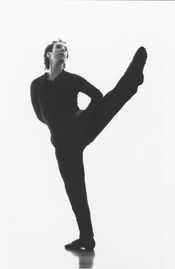Jeff Friedman, an assistant professor in the Department of Dance at the Mason Gross School of the Arts, brings two decades as a dancer and choreographer to his dual roles in the classroom and the studio. Following stints with Twyla Tharp and the experimental Oberlin Dance Collective, as well as a solo career that incorporated oral history and language theory into performances, Friedman was drawn to academia. He was one of the first students in the country to earn a doctorate in the emerging field of dance studies. At Rutgers, he continues to integrate scholarship with performance.
FOCUS: What prompted you to make the transition from performer to scholar?
Friedman: I developed an interest in oral history because dance colleagues in San Francisco were disappearing from AIDS, and I wanted to ensure records remained of their artistry. Developing an archive and learning oral history methods gave me insight into how history works from the inside. I became aware that dance research often was missing in the academy. While choreographing performances inspired by the oral histories and touring my solo dance, “Muscle Memory,” I was encouraged to pursue research by faculty at several university residencies. After completing my dissertation at the University of California, Riverside – the first university in the country to offer a Ph.D. in dance history and theory – I joined the faculty at Mason Gross, where I continue to develop my identities as a practicing artist and a scholar. To answer your question directly, from my experience where art-making is a form of research, I don’t see a hard-and-fast distinction between the two.

Friedman: There are, in fact, many types of records. There are graphic notations – the Russian dancer and choreographer Vaslav Nijinsky, for example, had his own form – that describe dance movements. There are drawings of dances that show the position of arms and legs, and print texts with descriptions. We also extrapolate from what was written against dancing to learn what people were doing. There are woodcuts from the Middle Ages showing people performing dances to keep away the plague, as well as writings by the church about what not to do, such as dances in graveyards to ward off death.
FOCUS: What tools do you and other contemporary dance scholars possess to record and analyze performances?
Friedman: Rudolf von Laban, an Austrian renaissance man of the late 19th century, developed a system to help us better describe, analyze, and document movement. Later generations of Laban scholars have developed computer-aided programs that transfer live movements onto computers. I use Laban Movement Analysis to study how people use nonverbal communication to tell their life stories in oral history interviews; my first book’s working title is Clio Unclothed: Embodying Language, Performing History.
FOCUS: What studio projects will you work on this year?
Friedman: I will reconstruct a dance from the 1970s called FORMAT V, which is based on an improvisational musical score created by experimental composer Randy Coleman. When the original choreographer, Brenda Way, received the written score in the mail, it was folded in half. She decided to interpret it as a dance up to the fold mark, and then to reverse the score back to its beginning. In the middle, the dancers have a series of spoken texts that stop short and reverse themselves. Dance students at Rutgers will need to learn how to walk and talk backwards! Look for updated variations on this early postmodern dance in the DancePlus concerts next spring.
FOCUS: What place does dance occupy in the academy?
Friedman: It has a fragile toehold. Dance in the academy developed out of a physical education model. Then in the 1930s, Margaret H’Doubler, a professor at the University of Wisconsin, began to teach the scientific aspects of dance, such as the mechanics of body movement. Today, dance studies is a much larger discipline than just dance itself, and looks more broadly at the role of bodies in cultures. Bodies are a lens through which to view so many topics of study, from nutrition to cultural anthropology to history. It is innately interdisciplinary. Dance studies also brings in populations that are marginalized. If you are studying African or African-American culture, for example, it behooves you to look at dance, which is central to both African and diaspora culture. I see dance studies as part of a larger movement to democratize the university.